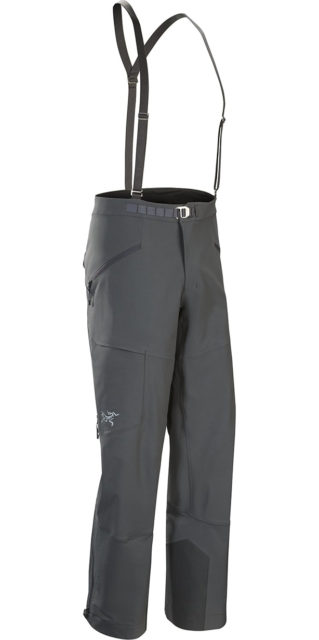
Arc’teryx Procline FL Pant
Reviewer: 5’8” 200 lbs
Size Tested: Large
Stated weight: 660 g / 23.3 oz
Blister’s Measured Weight: 658 g / 23.2 oz
Materials:
- Fortius 1.0™—84% nylon, 16% elastane, 160 g/m².
- Burly™ double weave—46% nylon, 46% polyester, 8% elastane, 275 g/m².
Stated Features:
- Arc’teryx Nu water repellent treatment
- Straight legs
- Trim fit for athletic performance
- Stretchy fabric allows you to move more freely
- Articulated patterning for unrestricted mobility
- Gusseted crotch for comfort and freedom of movement
- Front fly with snap closure
- Side zip ventilation with stretch mesh backer
- 1/4 length ankle zip with gusset and snap closure
- Glove friendly adjustable integrated webbing belt
- Keprotec™ instep patches provide superior protection against damage by boots, crampons and ski edges
- Powder cuffs with gripper elastic
- Low profile adjustable suspenders that are removable
Pockets:
- 2 hand pockets (zippered)
- 1 thigh cargo pocket (with velcro flap)
MSRP: $299.99
Days Tested: 40+
Test Locations: Boulder Hut, British Columbia; Grand Targhee, ID; Whitefish Mountain Resort, Glacier National Park, Great Bear Wilderness, & Flathead National Forest, MT
Intro
Arc’teryx’s Procline line is a collection of “ski alpinism systems for technical high performance in mountain environments,” and Arc’teryx specifically says the Procline FL soft shell pant is “designed to meet the varied demands of ski alpinism” and “provide performance and freedom for rigorous ascents and technical descents.” After over forty days in the Procline FL, I feel that I’ve got a good handle on the their function and durability, and they’ve become my favorite early and mid-season ski touring pant.
Fit
Arc’teryx claims that their Trim fit used on the Procline FL “employs a straight leg that minimizes bulk for a clear line of sight to the feet” and “keeps the material close to the body to help maximize moisture transfer while leaving room for light thermal layering.”
In the size Large that I tested, I didn’t find the fit to be particularly trim in the waist, thighs, or lower leg / cuff. Instead, the Procline FL’s “Trim” fit fell somewhere between the boxy roominess of Patagonia’s “Regular” fit and the tight contours of a spandex pant.
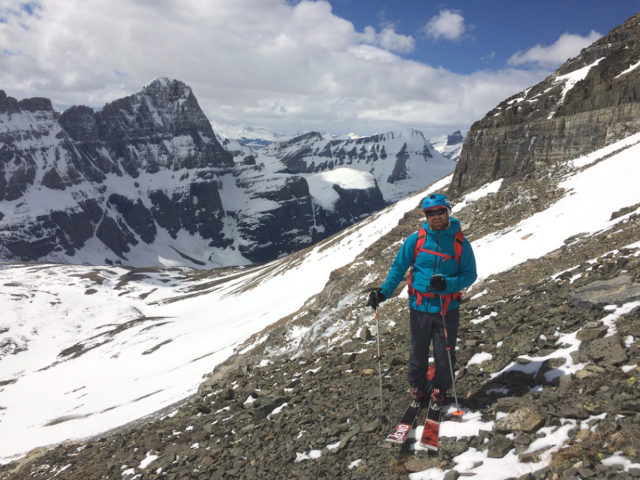
The Procline FL’s middle-of-the-road fit works very well for ski touring: relaxed, comfortable, and without a ton of extra fabric to fight, all the while remaining plenty moveable on long approaches and for kick turns. I really like this fit, but it’s not the really snug fit that some people may want. I’d definitely recommend trying on the Procline FL to see how they fit your body. Arc’teryx does offer Short and Tall options, so a better fit for more body shapes is certainly possible.
Some of the other “trim” pants out there (e.g. Mountain Equipment and Strafe) have larger, more bell-bottom style lower legs that leave extra fabric around the cuffs to snag on crampons and get stuck in bindings (and also work better with larger boots). The Procline FL’s cuffs are more moderate, but I never have to open up the gusset while using boots like the Atomic Backland Carbon (narrow upper cuff) and Salomon MTN Explore (mid-sized upper cuff). However, trying to fit them over the Salomon S/Lab X-Alp while it’s open (big upper cuff) or a larger, alpine boot is definitely difficult.
Fabric
The soft shell fabric on the Procline FL is a mix of Arc’teryx’s proprietary Fortius 1.0 and Burly Doubleweave, neither of which have a membrane. Both fabrics on the Procline FL have a slightly stiffer hand than many of the soft shells I’ve used (e.g. Mountain Equipment’s Exolite, Schoeller Dryskin), yet the Procline FL doesn’t feel crinkly like most hard shells.
This heavier, thicker-feeling fabric provides two main benefits that I’ll explain later: (1) increased water resistance when it starts to rain or snow and (2) better durability.
Both instep patches on the Procline FL are made from Keprotec, and though I’ve grazed and scuffed them with ski edges and crampons, the patches themselves have yet to tear through.
Weight and Packed Size
At 658 grams for a Large, the Procline FL is fairly light, but is significantly heavier than some other ski touring options like the Patagonia Snowdrifter (497 grams, review coming soon). If weight is truly a big concern for you, those ~160 grams might be worth thinking about.
When packed and cinched with a strap, the Procline is about the size of a standard 1L Nalgene.
Features
The Procline FL has three particularly standout features: the cuffs, vents, and integrated belt.
Integrated Belt & Suspenders
The belt on the Procline FL uses a metal clasp and sewn ladder of webbing and stitching to keep things simple, easy, and quick. I really like the integrated belt as it won’t fall out of belt loops like a standard belt (the Procline FL lacks external belt loops), and I also like not having to add a belt to the pant to begin with. Removable suspenders also come standard on the Procline FL.
The Cuffs
If there’s a weak point on the Procline, I think it’s in the stretch gusset and integrated gaiter at the bottom of the pants. Arc’teryx describes the design of the cuffs as follows: “[r]ealizing different situations often mean different boots, Arc’teryx designed the cuff with an integrated gusset. This gusset provides the adjustability required to create a secure fit over a range of boot volumes and collar heights.”
I found two problems with this claim. First, I don’t think that describing the cuffs as “secure” is all that accurate. The tension on the internal gaiter depends on the volume of the cuff of the boot that you’re using. The elastic is too loose to really cinch tight over boots with low-volume cuffs, like the Atomic Backland, or even the Salomon S/Lab X-Alp when it’s in ski mode.
When I stop to dig a pit and step off my skis, the whole cuff / gaiter slides up, and extended wallowing / postholing in soft snow often results in snow getting in the top of my boots. Folks that use bigger boots might find that the cuffs fit correctly, but I much prefer the cuffs of pants like the Patagonia Snowdrifter and Mountain Equipment Tour which have external snaps / cinches that help tighten the cuffs over smaller boots.
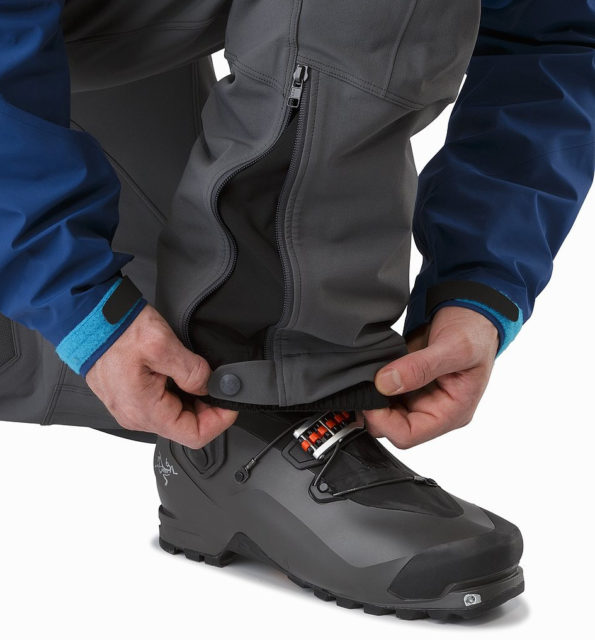
The second problem with the internal gaiter comes during transitions. On the gaiters of many of the ski pants available, you can set the grippy rubber gasket of the internal gaiter along the top of your boot. As you lift the outer cuff of the pant up and down, the gasket stays where it’s supposed to and you can access the buckles, then push the outer cuff of the pant down and go on your way.
However, on the Procline FL, the internal gaiter is only about two inches long, and attaches to the bottom of the pant leg very close to the hem. Every time I push the outer cuff up or down to adjust buckles at the top or bottom of a lap, the gasket drags over the buckles. This has torn up the fabric and stitching on the gasket, and when compounded by the ripping of the stitching across the Keprotec panel (discussed later), the whole gaiter now flops around in a way that it certainly wasn’t designed to do.
Needless to say, all this is a bit frustrating, especially given the attention Arc’teryx seems to have paid to the cuff, and the price tag, which is at the top end for a soft shell pant.
Pockets
The Procline FL pant comes with two zippered hand pockets featuring the softest interior fabric I’ve ever felt (seriously, it’s like puppy fur). This might not be important to everyone, but it’s very nice when you’re walking to the bar with cold hands.
The velcro thigh “dump” pocket is positioned well, securely holds a pair of light gloves or an avie notebook, but doesn’t have a zipper or integrated clip for a beacon. Clearly, Arc’teryx does not want you to put your beacon in there. The lack of a zipper is perplexing to me, but the pocket hasn’t opened up and picked up snow during my time in the pant, so I would just recommend not putting your valuables in there.
Weather Resistance
Despite just being a membrane-less soft shell with a DWR treatment (Arc’teryx calls the DWR “Nu”), the Procline FL’s fabric does a surprisingly good job of repelling precip. Consistent inch-an-hour, warm (27°F and above) snow did wet out the pant in the upper thighs, but at colder temps I haven’t experienced any issues with them getting wet, and they breathe better than hard shells.
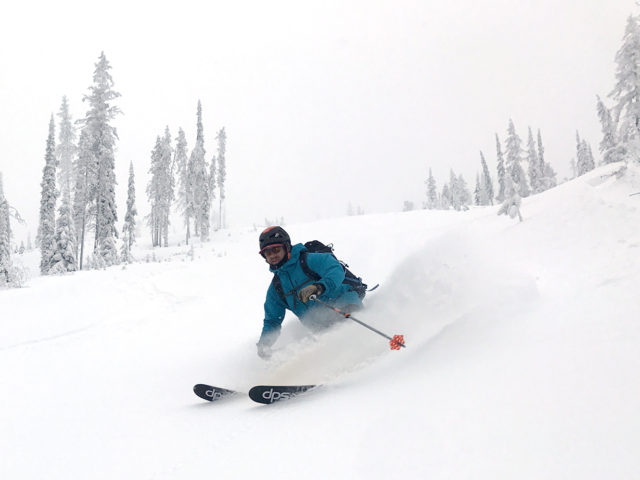
This makes the Procline FL really useful as an early and mid-winter soft shell pant. The question of whether to use a soft shell or hard shell often means sacrificing either waterproofing or breathability, respectively. The Procline FL makes that choice a little easier as the range of comfort is broader than thinner, less protective soft shell options like the Mountain Equipment Tour Pant or the Outdoor Research Ferrosi.
Breathability and Vents
As I noted above, the fabric on the Procline FL is thicker, more durable, and consequently a little less breathable than thinner / more minimal soft shells out there. For comparison, it’s still better than Neoshell when it comes to breathability, but cuts the wind about the same. However, the zippered, mesh-backed thigh vents on the Procline FL are the best I’ve ever used, and more than make up for any loss of venting through the fabric.
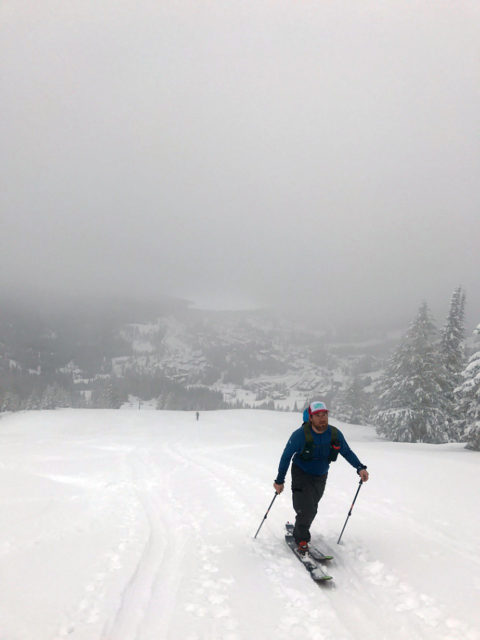
The vents are placed perfectly to dump heat, yet they stay clear of snow on deep skin tracks. Despite the mesh lining, they open plenty wide, and each stride up the skin track causes a little bit of airflow. The mesh backing keeps snow out, but still vents well. Best of all, I’ve had them snag only once in hundreds of cycles of zipping / unzipping. If I could put these on every ski pant I own, I would in a second.
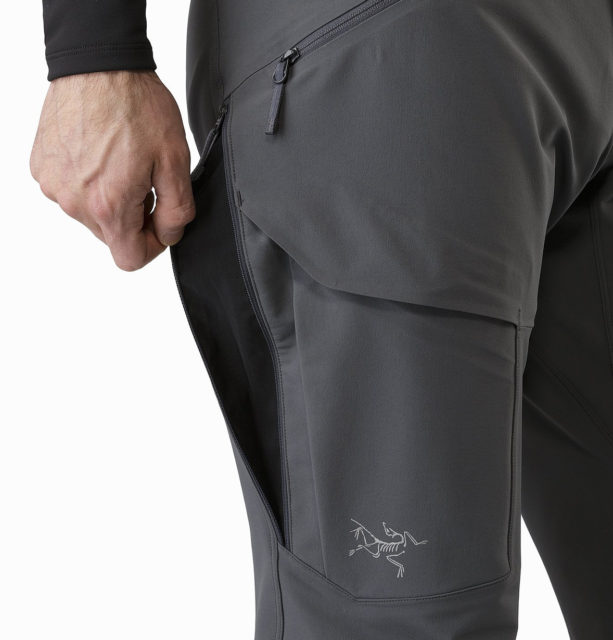
Durability
With more than forty days in the Procline FL, I’ve been impressed by the pant’s durability. However, this comes with one exception: the final binding seam in the lower cuff, which is stitched across the exterior lower third of the Keprotec instep patch.
Inevitably, crampons and ski edges scrape across this patch, tear the stitching (though the patch itself is still intact), and then the inner cuff, gaiter, and gasket all begin to move around. This has happened on both of the legs of the pair I tested, and also on another pair of pants I’m testing with a similar configuration of an exterior seam across the instep patch.
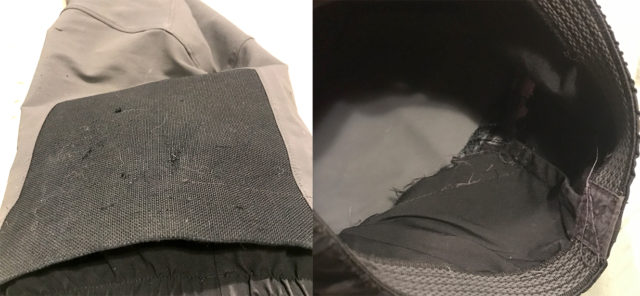
Though this has only been an issue for the last ~10 days of testing, it’s again a problem with the lower cuff / gaiter that Arc’teryx highlights in the Procline FL. By gluing or welding that seam, this would likely not be a problem (or if the seam were higher on the cuff). But since the seam thread is exposed on the cutting board of the Keprotec, it’s vulnerable to ski edges.
Who’s It For?
Arc’teryx positions the Procline FL as a soft shell pant for ski alpinists and ascent-focused skiers. Folks in that group who like a durable fabric that does well in lighter precip will be pretty pleased, but the cuff and gaiter issues with specific boots will likely be an issue for some of those people. Add onto that the baggier lower legs, and the Procline FL wouldn’t be my first choice for more technical trips where I have ice tools in my hands and skis on my back.
However, as a pant for dedicated ski touring, the Procline FL has worked very well through a ton of great days. These are not hyper-technical climbing pants — they’re ski pants with a more uphill oriented fit, fabric, and feature set. So if you like what you hear and are not planning to wear these with a harness, don’t fret.
It’s also worth touching on the price of the Procline FL — they’re significantly more expensive than many other similar options. While certain parts of the Procline FL are really nice (e.g. the versatile fit and excellent vents), there are definitely cheaper options out there that offer pretty similar performance (and I’ll be posting reviews of some of those options soon).
Bottom Line
The Arc’teryx Procline FL offers a solid combination of breathability, weather resistance, and functional features (apart from the cuffs). It wouldn’t be my first recommendation for those that are looking for a pant for serious ski mountaineering where you’ll be spending most of your time swinging tools and with crampons on your feet. But for a general touring pant, the Procline FL is a very capable option.

this was a very good review!!!